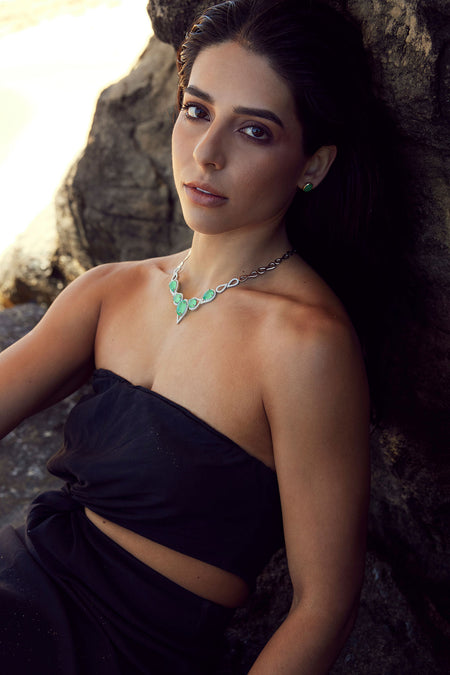

About Chrysoprase & Australian Chrysoprase
The world’s finest chrysoprase is found in Australia and is known throughout the world as Australian Jade.
Yerilla Australian Chrysoprase has been sought-after, coveted and desired for over seventy years since the discovery of the geologically unique deposits located in the harsh, arid outback of Western Australia.
This gemstone is renowned for its stunning colour, high translucency, and incredible likeness to Burmese Imperial Jadeite. Fine jewellery gemstone quality material is extremely rare and due to this rareness has remained a secret to the world. Simply put, there is no supply.
Today, the gemstone deposits are 100% owned, controlled and operated by Yerilla Fine Jewellery, who are a proud West Australian family.
The family oversees every facet of Yerilla from mining the precious material to the uncompromising process of cutting and polishing the gems, as well as the masterful designs with meticulous handcrafted details, earning their stellar reputation for fine quality and craftsmanship.
Technical
- Chrysoprase is a cryptocrystalline form of silica and the most valuable member of the Chalcedony family that derives its colour from traces of nickel that gives it the distinctive green colour, whereas a ruby derives its colour from traces of chromium.
- With no cleavage and hardness of 6.5 - 7 on Mohs scale, Chrysoprase makes an excellent gemstone for jewellery.
- Its specific gravity ranges between 2.65 - 2.90. This measures the density compared to water. Stones with higher specific gravity tend to be more vibrant and flawless.
- High quality Chrysoprase will be highly translucent, untreated and unaffected showing no cracks, fissures or inclusions, the colour should be evenly distributed.
- Chrysoprase has a unique ability to reflect and refract rays of light in a way that makes the stone glow as if it were alive.
Chrysoprase vs Jade: Distinguishing Two Green Gems
Chrysoprase and jade are distinct green gemstones often confused due to their colour.
Each possess their own unique characteristics. Chrysoprase, a variety of quartz, dazzles with its apple-green hues as a result of nickel content. Jade, encompassing both nephrite and jadeite, offers different green shades and occasionally surprises with colours like lavender or yellow.
The formation of these gemstones also differs. Chrysoprase forms in weathered nickel-rich serpentine rocks, while jade forms under high-pressure, low-temperature metamorphic conditions. This difference in formation contributes to their unique textures - chrysoprase typically has a smoother, more uniform appearance, while jade, especially nephrite, can have a more fibrous structure.
While both stones are prized for their beauty, their rarity and value can vary. High-quality Chrysoprase is appreciated for its vivid colour, rarity and smooth texture. Chrysoprase has been highly valued in Western cultures, particularly in ancient Greece and Rome, and throughout medieval Europe.
Camille – Australian Chrysoprase and diamond ring in 18ct rose & white gold
- Regular
- $5,445
- Sale
- $5,445
- Regular
-
- Unit Price
- per
Marella – Australian Chrysoprase, diamond and pearl earrings in 18ct white gold
- Regular
- $14,091
- Sale
- $14,091
- Regular
-
- Unit Price
- per
Luna – Australian Chrysoprase and diamond pendant in 18ct white gold
- Regular
- $6,318
- Sale
- $6,318
- Regular
-
- Unit Price
- per
Aurora – Australian Chrysoprase and diamond ring in 9ct yellow gold
- Regular
- $2,045
- Sale
- $2,045
- Regular
-
- Unit Price
- per
Faith – Australian Chrysoprase and diamond ring in 18ct white gold
- Regular
- $10,818
- Sale
- $10,818
- Regular
-
- Unit Price
- per
Aurelia – Australian Chrysoprase and diamond pendant in 18ct white & yellow gold
- Regular
- $2,718
- Sale
- $2,718
- Regular
-
- Unit Price
- per
Cerise – Australian Chrysoprase in 9ct yellow gold
- Regular
- $2,182
- Sale
- $2,182
- Regular
-
- Unit Price
- per
Demi – Australian Chrysoprase earrings in 9ct yellow gold
- Regular
- $1,455
- Sale
- $1,455
- Regular
-
- Unit Price
- per

















